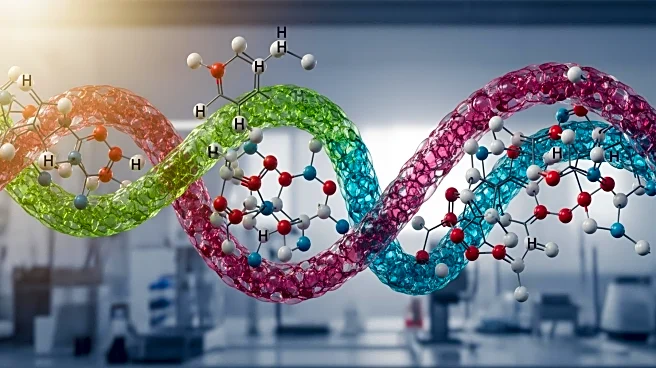What's Happening?
Recent research has focused on the structural changes and viscosity variations in interpolymer complexes formed by poly(2-ethyl-2-oxazoline) and poly(methacrylic acid). The study highlights how controlling
hydrogen bonds between polymer chains can significantly alter the properties of these complexes. By adjusting the solvent pH or adding urea, researchers observed drastic changes in viscosity. At a solvent pH of approximately 12, the viscosity increased, while at pH 13, it decreased, indicating a dissociation into free polymer chains. Infrared spectra analysis showed a decrease in hydrogen bond formation with increasing pH levels. Additionally, the introduction of urea at concentrations above 6 M further increased the viscosity, suggesting an expansion in the dimension of the interpolymer complex.
Why It's Important?
Understanding the behavior of interpolymer complexes and their viscosity changes has significant implications for material science and engineering. These findings could lead to advancements in the design of polymeric materials with tailored properties for specific applications, such as drug delivery systems, coatings, and adhesives. The ability to control hydrogen bonding and thus manipulate the physical properties of polymers opens new avenues for innovation in various industries. Companies and researchers focusing on polymer technology stand to benefit from these insights, potentially leading to more efficient and effective material solutions.
What's Next?
Future research may explore the application of these findings in real-world scenarios, such as developing new polymer-based products with enhanced performance characteristics. There is potential for collaboration between academic institutions and industry leaders to further investigate the practical applications of these interpolymer complexes. Additionally, exploring other variables that affect hydrogen bonding and polymer behavior could lead to broader applications and innovations in material science.
Beyond the Headlines
The study of interpolymer complexes and their behavior under different conditions also raises questions about the environmental impact and sustainability of polymer production and usage. As industries seek to reduce their ecological footprint, understanding the fundamental properties of polymers can contribute to the development of more sustainable materials. Ethical considerations regarding the use of chemical additives like urea in polymer processing may also emerge, prompting discussions on safe and responsible material development.













